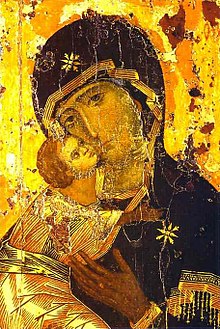
A palladium or palladion (plural palladia) is an image or other object of great antiquity on which the safety of a city or nation is said to depend. The word is a generalization from the name of the original Trojan Palladium, a wooden statue (xoanon) of Pallas Athena that Odysseus and Diomedes stole from the citadel of Troy. It was supposedly later taken to the future site of Rome by Aeneas, where it remained until perhaps transferred to Constantinople and was lost after the Empire converted to Christianity.
In English, since around 1600, the word "palladium" has been used figuratively to mean anything believed to provide protection or safety,[1] and in particular in Christian contexts a sacred relic or icon believed to have a protective role in military contexts for a whole city, people or nation. Such beliefs first become prominent in the Eastern Churches in the period after the reign of the Byzantine Emperor Justinian I, and later spread to the Western church. Palladia were processed around the walls of besieged cities and sometimes carried into battle.[2] In this more offensive role they may also be referred to as "vexilla" (singular vexillum, Latin for "battle standard").